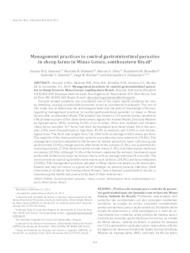Management practices to control gastrointestinal parasites in sheep farms in Minas Gerais, southeastern Brazil.
Management practices to control gastrointestinal parasites in sheep farms in Minas Gerais, southeastern Brazil.
Autoria: GOUVEIA, A. M. G.; MOLENTO, M. B.; SILVA, M. X.; BRANDAO, H. de M.; GOUVEIA, G. C.; MORLÁN, J. B.; GUIMARAES, A. S.
Resumo: Parasite related problems are considered one of the major health problems for sheep breeding, causing considerable economic losses to commercial husbandry. The aim of this study was to determine the technological level and the level of knowledge of farmers regarding management practices to control gastrointestinal parasites in sheep in Minas Gerais state, southeastern Brazil. The analysis was based on 213 questionnaires applied by official veterinarians of the State Government Agency for Animal Health (Instituto Mineiro de Agropecuária, IMA), covering 16.6% of all counties. From two hundred and thirteen sheep farms sampled, 117 farms had their technological level determined. From the samples, 0.9% were characterized as high level, 45.3% as medium, and 53.0% as low technological level. The flock size ranged from 2 to 1843 with an average of 80.5 sheep per farm. The majority of the sheep production systems was extensive/semi-extensive (74.5%). The management practices adopted by the farmers to reduce parasitism were: split young and adult animals (5.6%), change pasture after deworm the animals (5.2%), use quarantine for incoming animals (2.3%), deworm newly arrived sheep (1.5%), and have regular technical assistance (31.9%). Although 76.5% of the farmers medicate the animals, treatments were performed without any major technical criteria, with an average interval of 4.6 months. The most commonly used drug families were macrocyclic lactones (38.5%) and benzimidazoles (24.9%). The management practices adopted in Minas Gerais are based on old recommendations and may not return in a good set of strategies to prevent parasite infections. Field observations reinforce the finding where farmers have obtained unsatisfactory results in maintaining the health and productivity level of their enterprises.
Ano de publicação: 2013
Tipo de publicação: Artigo de periódico
Unidade: Embrapa Gado de Leite
Palavras-chave: Epidemiological aspects, Gastrointestinal parasites, Sheep control, Technological level
Observações
1 - Por padrão são exibidas publicações dos últimos 20 anos. Para encontrar publicações mais antigas, configure o filtro ano de publicação, colocando o ano a partir do qual você deseja encontrar publicações. O filtro está na coluna da esquerda na busca acima.
2 - Para ler algumas publicações da Embrapa (apenas as que estão em formato ePub), é necessário ter, no celular ou computador, um desses softwares gratuitos. Sistemas Android: Google Play Livros; IOS: iBooks; Windows e Linux: software Calibre.
Acesse outras publicações
Acesse a Base de Dados da Pesquisa Agropecuária (BDPA) para consultar o acervo completo das bibliotecas da Embrapa.

